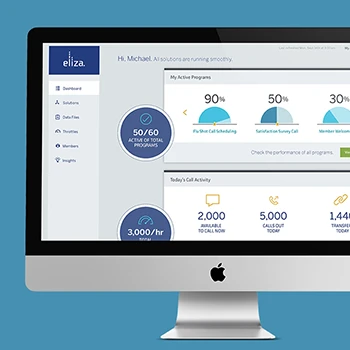What exactly is digital transformation strategy and how does it differ from technology upgrades?
Digital transformation strategy creates innovative organizational cultures focused on delivering exceptional customer and user experiences through digital capabilities. Unlike technology upgrades that simply replace tools, transformation strategy fundamentally changes how organizations operate, make decisions, and create value. Using the Experience Thinking framework, it addresses brand evolution, content strategy, product development, and service delivery as an integrated system that leverages digital capabilities to enhance the complete customer experience lifecycle.
Tip: Evaluate whether your transformation strategy addresses organizational culture change and customer experience enhancement, not just technology implementation.
Why do organizations need digital transformation strategy consulting?
Organizations struggle with digital transformation because it requires coordinating people, business models, processes, and technology simultaneously while maintaining operational excellence. Most organizations excel in one area but fail to achieve the alignment necessary for transformation success. Strategy consulting provides frameworks for managing this complexity, systematic approaches to change management, and experience-oriented perspectives that ensure digital investments create customer value rather than just operational efficiency.
Tip: Assess your organization's alignment across people, business models, processes, and technology before starting transformation initiatives to identify potential failure points.
What makes digital transformation strategy successful?
Successful digital transformation strategy starts with experience creation rather than technology implementation. It requires systematic organizational development that embeds customer-centered thinking across all business functions while building capabilities for continuous adaptation. The Experience Thinking approach ensures transformation efforts create connected experiences across brand, content, product, and service touchpoints rather than optimized individual systems that remain disconnected from customer value creation.
Tip: Prioritize experience outcomes and organizational capability development over technology feature implementation to ensure sustainable transformation success.
How does digital transformation strategy connect to business outcomes?
Digital transformation strategy creates direct connections between digital capabilities and business results through systematic measurement of customer experience improvements, operational efficiency gains, and competitive positioning enhancements. Strategy frameworks establish governance systems that balance exploration of new digital opportunities with execution excellence, ensuring transformation investments generate measurable returns through enhanced customer relationships, improved market responsiveness, and sustainable competitive advantages.
Tip: Establish measurement systems that track customer experience improvements and competitive positioning changes alongside traditional operational metrics to demonstrate transformation value.
What's the relationship between digital transformation and customer experience?
Digital transformation enables organizations to create more responsive, personalized, and valuable customer experiences by leveraging technology to enhance human connections rather than replacing them. The transformation focuses on using digital capabilities to better understand customer needs, deliver more relevant solutions, and maintain relationships throughout the experience lifecycle. This requires understanding how customers evolve from initial prospects to users and ultimately loyal clients, with different digital needs at each stage.
Tip: Map your digital transformation initiatives against the complete customer lifecycle rather than focusing only on acquisition or operational efficiency improvements.
How do you determine the right digital transformation approach for our organization?
The right approach emerges from understanding your strategic context, organizational maturity, and market position while assessing current capabilities across people, business models, processes, and technology. Foresight design methodologies help anticipate future market conditions and customer expectations that should inform transformation direction. The assessment includes stakeholder analysis, competitive positioning evaluation, and systematic capability gap analysis that identifies transformation priorities based on strategic impact and organizational readiness.
Tip: Conduct capability assessments across all four organizational areas (people, business, process, technology) to identify the most critical transformation constraints before developing implementation strategies.
What role does organizational culture play in digital transformation?
Culture provides the foundation that enables digital transformation success by creating psychological safety for experimentation, shared commitment to customer value creation, and systematic approaches to continuous learning and adaptation. Experience-oriented cultures ensure business and development processes focus on creating desired experiences rather than just implementing technology solutions. Culture transformation requires deliberate action, planned communication, training, and ongoing support systems that maintain focus on experience creation as the primary transformation objective.
Tip: Invest in systematic culture development programs that embed experience thinking across all functions rather than expecting technology implementation alone to drive cultural change.
How does the Experience Thinking framework apply to digital transformation?
Experience Thinking provides a holistic framework that integrates brand, content, product, and service transformation into unified digital strategy. Rather than transforming individual systems in isolation, Experience Thinking ensures digital capabilities create connected experiences across all customer touchpoints. The framework addresses how digital transformation impacts brand expression, content delivery, product functionality, and service experiences as an integrated ecosystem that enhances the complete customer lifecycle from awareness through advocacy.
Tip: Map your digital transformation initiatives across all four Experience Thinking quadrants to identify gaps where disconnected efforts might limit overall transformation impact.
What's the difference between digital transformation and experience transformation?
Digital transformation focuses on implementing technology capabilities, while experience transformation uses digital tools to create better customer and user experiences. Experience transformation recognizes that technology alone doesn't create value; it's how technology enables better human experiences that drives business outcomes. Using the Experience Thinking framework, experience transformation addresses emotional responses, relationship development, and long-term customer value creation rather than just operational efficiency and digital capability deployment.
Tip: Focus transformation planning on experience outcomes and relationship enhancement rather than just digital capability acquisition to ensure sustainable competitive advantage.
How do you create connected experiences through digital transformation?
Connected experiences result from systematic integration of digital capabilities across brand, content, product, and service touchpoints that create coherent value propositions throughout the customer journey. The Experience Thinking approach ensures transformation efforts orchestrate complete experience ecosystems rather than optimizing individual digital touchpoints. This requires understanding how customers, users, and clients have different needs and expectations as they progress through their relationship lifecycle with your organization.
Tip: Design digital transformation initiatives that strengthen experience connections across touchpoints rather than improving individual systems in isolation.
What's your approach to brand transformation in digital environments?
Brand transformation in digital environments requires understanding how digital touchpoints express brand personality and values while maintaining consistency across all customer interactions. Digital brand transformation goes beyond visual identity updates to include how brand promise translates into digital functionality, content strategy, and service delivery. The transformation addresses tone of voice in digital interactions, brand expression through user interface design, and systematic approaches to brand governance across all digital touchpoints and customer experience moments.
Tip: Develop brand expression guidelines specifically for digital interactions that maintain personality consistency while adapting to different digital contexts and customer journey stages.
How does content strategy transform in digital environments?
Content strategy transformation involves creating systematic approaches to content creation, management, and distribution that support enhanced customer experiences across all digital touchpoints. This includes developing content governance frameworks, audience-centered content architectures, and measurement systems that optimize content performance across the experience lifecycle. Content transformation addresses how information supports customer decision-making, enables task completion, and maintains ongoing relationship value through relevant, timely, and accessible digital content experiences.
Tip: Establish content governance frameworks that ensure consistency and quality across all digital touchpoints rather than managing content creation separately for each channel or system.
What's your approach to product experience transformation?
Product experience transformation uses digital capabilities to create more intuitive, valuable, and engaging product interactions that solve customer problems effectively while being enjoyable to use. This involves developing user research capabilities, design system governance, and systematic testing approaches that ensure product enhancements align with customer needs and business objectives. Product transformation includes developing prototyping capabilities, measurement frameworks, and continuous improvement processes that maintain product experience quality through ongoing digital evolution.
Tip: Implement user research operations that can support both product optimization and exploration of new digital product opportunities rather than limiting research to usability validation.
How do you transform service experiences through digital capabilities?
Service experience transformation leverages digital tools to improve service delivery efficiency, personalization, and accessibility while maintaining human connection quality where it matters most. This includes developing service blueprints that integrate digital and human touchpoints, creating customer support systems that enhance rather than replace human interaction, and establishing service measurement frameworks that optimize both operational efficiency and relationship quality. Foresight design approaches help anticipate future service needs and design adaptive service systems.
Tip: Design service transformation that enhances human capabilities and connections rather than simply automating service processes to reduce operational costs.
How do you align people, business models, processes, and technology for transformation?
Transformation alignment requires systematic coordination across all four organizational areas with shared commitment to experience creation as the primary objective. People alignment involves hiring right competencies, training existing staff, and creating supportive culture. Business model alignment ensures economic incentives reward experience quality over short-term transactions. Process alignment develops cross-functional workflows that support connected experience creation. Technology alignment focuses on enabling great experiences rather than just building functional systems.
Tip: Conduct alignment assessments across all four areas before starting transformation initiatives to identify potential conflicts that could undermine transformation success.
What's your approach to change management in digital transformation?
Change management requires systematic approaches that address specific resistance sources while demonstrating incremental transformation value through pilot programs and success communication. The approach includes stakeholder analysis, communication frameworks, and training programs that build transformation capabilities across the organization. Change management also involves creating governance systems that balance transformation exploration with operational stability, ensuring change efforts maintain business performance while building new capabilities.
Tip: Address change resistance through partnership and demonstration rather than education alone to build genuine organizational support for transformation practices.
How do you develop digital transformation leadership capabilities?
Digital transformation leadership requires skills that go beyond traditional management to include systems thinking, cross-functional collaboration, and strategic communication that embeds transformation thinking into organizational decision-making. Leadership development includes executive education, stakeholder engagement strategies, and change management approaches that create transformation advocates across the organization. Leaders need capabilities in experience strategy, digital innovation management, and organizational development that enables sustained transformation success.
Tip: Focus on creating transformation advocates and capabilities within all business functions rather than centralizing transformation leadership within technology or innovation departments alone.
What governance frameworks do you establish for digital transformation?
Transformation governance balances strategic guidance with execution flexibility through frameworks that provide direction without stifling innovation and adaptation. Governance systems include decision-making authorities, resource allocation processes, and success measurement that maintains transformation focus while enabling rapid response to market changes. The frameworks focus on outcomes and strategic alignment rather than detailed process requirements, allowing organizations to adapt approaches while maintaining transformation coherence and business accountability.
Tip: Design governance systems that focus on transformation outcomes and strategic alignment rather than detailed process control to maintain flexibility while ensuring progress.
How do you handle transformation in complex organizational environments?
Complex organizations require transformation strategies that work across diverse business units, geographic regions, and cultural contexts while maintaining strategic coherence. The approach includes developing frameworks that distinguish between universal transformation principles and local adaptation opportunities. Complex environment transformation requires sophisticated stakeholder management, communication systems, and coordination mechanisms that enable distributed transformation execution while maintaining overall strategic direction and experience quality standards.
Tip: Create transformation frameworks that specify which elements require consistency across the organization and which allow local adaptation rather than trying to standardize all transformation approaches.
What's your approach to cross-functional collaboration in transformation?
Cross-functional collaboration requires systematic development of shared language, aligned objectives, and collaborative workflows that leverage each function's transformation contributions. This includes creating hybrid roles, cross-functional rituals, and shared accountability systems that enable genuine partnership rather than handoff relationships between marketing, product, technology, and operations. Collaboration frameworks address how different functions contribute to transformation success while maintaining their specialized expertise and operational effectiveness.
Tip: Establish shared transformation success metrics across all functions rather than trying to improve collaboration through communication training workshops alone.
How do you measure digital transformation success?
Transformation measurement requires sophisticated frameworks that connect transformation activities to business outcomes through both leading and lagging indicators. Measurement systems track customer experience improvements, operational efficiency gains, competitive positioning changes, and organizational capability development. The frameworks include predictive metrics that anticipate business outcomes from transformation activities, enabling course correction and resource optimization rather than just reporting on transformation activity completion and stakeholder satisfaction levels.
Tip: Develop measurement capabilities that predict business outcomes from transformation activities rather than just tracking project completion rates and technology implementation milestones.
How do you create actionable digital transformation roadmaps?
Transformation roadmaps connect strategic vision with specific implementation steps across multiple time horizons while addressing capability development, technology implementation, and experience enhancement as integrated initiatives. Using Experience Thinking principles, roadmaps ensure brand evolution, content strategy, product development, and service transformation align to create competitive advantages. The roadmaps include resource allocation, milestone definition, success criteria, and governance frameworks that enable systematic progress tracking and strategic course correction as market conditions evolve.
Tip: Design transformation roadmaps that prioritize organizational capability building and customer experience enhancement rather than just technology implementation timelines and feature development schedules.
What's your approach to transformation resource allocation?
Resource allocation requires sophisticated portfolio management that balances transformation opportunities with operational maintenance across different time horizons and risk profiles. The approach includes developing business cases for transformation investments, creating allocation frameworks that optimize resource deployment, and establishing success measurement systems that demonstrate transformation value to stakeholders. Resource allocation also addresses how to distribute efforts between breakthrough transformation initiatives and incremental improvement projects that maintain operational excellence during change periods.
Tip: Allocate specific percentages of resources to transformation exploration and capability development rather than trying to transform within existing operational improvement budgets and timelines.
How do you prioritize transformation initiatives?
Prioritization frameworks balance strategic impact with organizational capability and market timing considerations while ensuring transformation efforts create coherent customer value rather than disconnected improvements. The approach includes developing evaluation criteria that assess both customer experience impact and business outcome potential, combined with implementation feasibility and resource requirement analysis. Foresight design methodologies help identify initiatives that position organizations for future market conditions rather than just addressing current operational challenges.
Tip: Prioritize transformation initiatives based on customer experience impact and strategic positioning potential rather than just operational efficiency gains or technology modernization requirements.
What's your approach to pilot program design and scaling?
Pilot programs test transformation approaches in controlled environments while building organizational confidence and capability for broader implementation. Pilot design includes clear success criteria, systematic learning capture, and scaling frameworks that enable broader deployment while maintaining transformation quality. The approach addresses how to select appropriate pilot contexts, engage stakeholders effectively, and document insights that inform broader transformation strategies while managing change resistance and operational disruption risks.
Tip: Design pilot programs that test both customer experience improvements and organizational capability development rather than just validating technology functionality and operational efficiency gains.
How do you handle transformation risk management?
Transformation risk management requires systematic identification and mitigation of technical, organizational, and market risks while maintaining appropriate levels of innovation and change velocity. Risk management includes developing contingency plans, creating early warning systems, and establishing governance processes that enable rapid response to emerging challenges. The approach balances transformation ambition with operational stability, ensuring change efforts don't compromise business performance while building capabilities for sustained competitive advantage through enhanced customer experiences.
Tip: Develop risk management approaches that protect operational performance while enabling transformation experimentation rather than avoiding all change risks through excessive caution and planning.
What's your approach to vendor partnership in digital transformation?
Vendor partnerships require strategic frameworks that leverage external expertise while building internal transformation capabilities and maintaining strategic control over transformation direction. Partnership strategies include evaluation criteria, collaboration models, and governance systems that access specialized capabilities without creating dependency or losing transformation learning opportunities. The approach addresses how to structure partnerships that transfer knowledge effectively while maintaining organizational ownership of transformation strategy and customer relationship quality.
Tip: Structure vendor partnerships to build internal transformation capabilities alongside delivering project outcomes rather than outsourcing transformation strategy and execution entirely to external organizations.
How do you ensure transformation sustainability?
Transformation sustainability requires building organizational systems and capabilities that enable continuous adaptation and improvement rather than depending on individual transformation projects or initiatives. Sustainability includes developing learning systems, governance frameworks, and culture elements that maintain transformation focus and capability over time. The approach addresses how to embed transformation thinking into regular business operations, decision-making processes, and strategic planning cycles that sustain transformation momentum through leadership changes and market evolution.
Tip: Focus transformation sustainability on building systematic organizational capabilities and cultural practices rather than depending on specific technology implementations or individual change initiatives alone.
How do you build digital transformation capabilities across the organization?
Capability development focuses on building systematic organizational systems rather than individual technical skills, including transformation leadership, cross-functional collaboration, and strategic thinking that enables sustained competitive advantage. The approach includes developing research operations, design system governance, experimentation frameworks, and customer insight capabilities that support ongoing transformation rather than one-time change initiatives. Capability development addresses how to create learning systems and knowledge management that capture and distribute transformation insights across the organization effectively.
Tip: Focus on building transformation capabilities that can scale across organizational growth and market changes rather than just training people in specific tools or current transformation projects.
What's your approach to digital skills development?
Digital skills development goes beyond technology training to include strategic thinking, customer insight development, and systematic approaches to digital problem-solving that enhance customer experience creation. Skills development includes research capabilities, design thinking application, data analysis interpretation, and cross-functional collaboration that enables effective transformation execution. The approach addresses both current skill gaps and future capability requirements, ensuring organizations can adapt to emerging digital opportunities and market changes through continued learning and development.
Tip: Develop digital skills that enhance customer experience creation and strategic thinking rather than focusing only on technical tool proficiency and operational efficiency improvements.
How do you establish transformation centers of excellence?
Centers of excellence provide organizational focus for transformation capability development while enabling distributed application across business functions and contexts. Center design includes governance structures, resource allocation, and knowledge sharing systems that accelerate transformation capability development and application. The approach addresses how to balance centralized expertise with decentralized execution, ensuring transformation knowledge transfers effectively while maintaining quality standards and strategic alignment across diverse organizational contexts and transformation initiatives.
Tip: Design centers of excellence that focus on capability development and knowledge sharing rather than controlling all transformation activities centrally through specialized departments or external consultants.
What's your approach to transformation research and insights?
Transformation research requires advanced methodologies that understand customer behavior evolution, market trend analysis, and organizational capability assessment that inform strategic transformation decisions. Research capabilities include longitudinal studies, ethnographic analysis, competitive intelligence, and systematic experimentation that provide insights for transformation direction and prioritization. The approach addresses how to build research operations that support both transformation strategy development and ongoing optimization of transformation initiatives through continuous learning and market feedback integration.
Tip: Build research capabilities that can support both strategic transformation planning and ongoing optimization rather than limiting research to project validation or technology implementation feedback.
How do you develop transformation measurement and analytics capabilities?
Measurement capabilities require sophisticated approaches that connect transformation activities to business outcomes while providing insights for continuous improvement and strategic adjustment. Analytics development includes establishing data collection systems, analysis frameworks, and reporting mechanisms that optimize transformation resource deployment and strategy refinement. The approach addresses both quantitative performance metrics and qualitative experience assessment, ensuring measurement provides actionable insights rather than just activity reporting and compliance documentation.
Tip: Develop measurement capabilities that provide strategic insights for transformation optimization rather than just tracking activity completion and technology implementation progress metrics.
What role does AI play in digital transformation strategy?
AI enhances digital transformation through pattern recognition, process automation, and insight generation rather than replacing human strategic thinking and customer relationship management. AI applications include customer behavior analysis, content personalization, operational optimization, and predictive analytics that inform transformation decisions. However, transformation strategy requires human judgment for complex organizational change, customer experience design, and strategic positioning decisions. AI tools accelerate transformation capability but cannot replace systematic thinking about customer needs and organizational development.
Tip: Use AI to enhance transformation analysis and operational efficiency while maintaining human oversight for strategic decisions, customer experience design, and organizational change management.
How do you build transformation innovation capabilities?
Innovation capabilities require systematic approaches to exploration, experimentation, and implementation that balance breakthrough opportunities with operational excellence while maintaining customer value focus. Innovation development includes establishing experimentation frameworks, prototype development capabilities, and systematic approaches to market testing that enable rapid learning and adaptation. Foresight design methodologies help organizations develop capabilities for anticipating future market needs and customer expectations that inform transformation direction and competitive positioning strategies.
Tip: Build innovation capabilities that focus on customer value creation and market opportunity development rather than just technology experimentation and internal process optimization.
How does digital transformation impact the customer lifecycle?
Digital transformation enables organizations to create more responsive and personalized experiences throughout the customer lifecycle while understanding how customers evolve from initial prospects to users and ultimately loyal clients. Each lifecycle stage requires different digital capabilities: customer acquisition focuses on digital marketing and decision support; user engagement emphasizes product functionality and task completion; client relationship management prioritizes loyalty building and advocacy development. Digital transformation ensures capabilities align with lifecycle stage needs rather than applying uniform approaches.
Tip: Map digital transformation initiatives against the complete customer lifecycle stages rather than focusing only on acquisition efficiency or operational automation improvements.
What's your approach to omnichannel transformation strategy?
Omnichannel transformation requires coordinated strategies across all customer touchpoints that create seamless experiences rather than optimized individual channels operating independently. Using Experience Thinking methodology, omnichannel transformation addresses brand consistency, content coordination, product accessibility, and service integration across digital and physical touchpoints. The approach includes developing channel integration frameworks, consistent measurement systems, and governance processes that maintain experience coherence while adapting to channel-specific requirements and customer preferences.
Tip: Focus omnichannel transformation on experience consistency and value coherence across channels rather than achieving identical functionality and appearance on all customer touchpoints.
How do you transform customer support and service through digital capabilities?
Service transformation leverages digital tools to enhance service delivery while maintaining human connection quality where it creates the most customer value. This includes developing service blueprints that integrate digital self-service with human support, creating knowledge management systems that enable consistent service quality, and establishing measurement frameworks that optimize both efficiency and relationship satisfaction. Service transformation addresses how to use digital capabilities to anticipate customer needs and provide proactive support rather than just reactive problem resolution.
Tip: Design digital service transformation that enhances human service capabilities and enables proactive support rather than simply reducing service operational costs through automation.
What's your approach to personalization in digital transformation?
Personalization uses digital capabilities to create more relevant and valuable customer experiences while respecting privacy and maintaining authentic human connection. Personalization strategy includes developing customer insight capabilities, content management systems, and delivery mechanisms that adapt to individual preferences and behavioral patterns. The approach addresses how to balance automation efficiency with personal relevance, ensuring personalization enhances rather than replaces human relationship building and maintains customer trust through transparent and valuable data usage.
Tip: Focus personalization on enhancing customer value and relationship quality rather than just increasing operational efficiency and marketing conversion rates through automated targeting.
How do you measure customer experience transformation success?
Customer experience measurement requires frameworks that assess both quantitative performance improvements and qualitative relationship enhancement across all touchpoints and lifecycle stages. Measurement systems track satisfaction increases, engagement improvements, loyalty development, and advocacy generation attributable to transformation initiatives. The frameworks include both leading indicators of experience health and lagging indicators of business impact, enabling optimization of transformation resource allocation and strategy refinement based on customer response and business outcome achievement.
Tip: Establish customer experience measurement that tracks relationship quality and lifecycle progression rather than just individual touchpoint satisfaction scores and operational efficiency metrics.
What's your approach to customer feedback integration in transformation?
Feedback integration requires systematic approaches to customer insight collection, analysis, and application that inform ongoing transformation strategy and implementation refinement. Integration systems include establishing feedback collection mechanisms, analysis capabilities, and organizational processes that translate customer insights into transformation improvements. The approach addresses how to create continuous learning loops that adapt transformation approaches based on customer response while maintaining strategic coherence and operational stability during change implementation.
Tip: Create systematic feedback integration processes that influence transformation strategy and implementation rather than just collecting customer satisfaction data for reporting purposes.
How do you ensure transformation creates connected customer experiences?
Connected experiences result from systematic integration of transformation initiatives across all customer touchpoints that create coherent value propositions throughout the customer journey. The Experience Thinking approach ensures transformation efforts orchestrate complete experience ecosystems rather than improving individual digital systems independently. This requires understanding connection points between touchpoints, developing integration frameworks, and establishing governance systems that maintain experience coherence while enabling innovation and adaptation in response to market changes and customer evolution.
Tip: Audit transformation initiatives for experience connections across all customer touchpoints to ensure individual improvements strengthen rather than fragment overall customer value and relationship quality.
How do you measure the business impact of digital transformation strategy?
Transformation impact measurement requires frameworks that connect transformation activities to business outcomes through both quantitative metrics and qualitative assessments across multiple time horizons. Measurement systems track revenue improvements, cost optimization, market share changes, customer satisfaction increases, and competitive positioning enhancements attributable to transformation initiatives. The approach includes both leading indicators of transformation health and lagging indicators of business impact, enabling resource optimization and strategy refinement based on outcome achievement rather than just activity completion.
Tip: Establish measurement systems that demonstrate transformation's contribution to competitive advantage and market positioning rather than just operational efficiency improvements and cost reduction achievements.
What organizational changes result from successful digital transformation?
Successful transformation creates systematic organizational changes including enhanced decision-making speed, improved cross-functional collaboration, increased market responsiveness, and stronger competitive positioning through better customer experiences. Organizations develop transformation culture, systematic learning capabilities, and adaptive strategic planning that enables continuous evolution in response to market changes. The transformation includes both structural changes and capability development that sustains competitive advantage through ongoing adaptation rather than one-time improvement achievements.
Tip: Focus organizational change measurement on systematic capability development and cultural evolution rather than just project completion and technology implementation success rates.
How do you ensure digital transformation creates lasting competitive advantage?
Lasting competitive advantage requires transformation strategies that build organizational capabilities and strategic positioning rather than just implementing digital tools that competitors can replicate. Advantage creation includes developing unique customer insight sources, distinctive experience delivery capabilities, and systematic innovation processes that enable continuous market leadership. Foresight design approaches help organizations anticipate future market conditions and build adaptive capabilities that maintain relevance through technological and customer expectation evolution over extended time periods.
Tip: Build transformation competitive advantage through distinctive organizational capabilities and customer relationship quality rather than relying primarily on technology implementations or digital tool adoption alone.
What's your approach to scaling transformation success across large organizations?
Transformation scaling requires frameworks that maintain strategic coherence while enabling local adaptation across diverse business contexts, geographic regions, and cultural environments. Scaling strategies distinguish between universal transformation principles and local implementation flexibility while providing governance systems that coordinate distributed transformation efforts. The approach includes communication frameworks, capability development programs, and success sharing mechanisms that enable coordinated transformation while respecting local market requirements and organizational constraints.
Tip: Create transformation scaling frameworks that maintain strategic alignment and experience quality while enabling appropriate local adaptation rather than imposing identical approaches across all organizational contexts.
How do you maintain digital transformation momentum over time?
Transformation momentum requires systematic approaches to continuous improvement, regular strategy refresh, and organizational learning that prevents transformation initiatives from losing energy and focus over extended implementation periods. Momentum maintenance includes establishing governance systems, communication strategies, and celebration mechanisms that sustain transformation enthusiasm and business support through leadership changes and market evolution. The approach addresses how to embed transformation thinking into regular business operations and decision-making processes for sustained organizational change.
Tip: Create systematic approaches to transformation momentum maintenance through embedded organizational processes rather than relying on initial project enthusiasm or individual leadership commitment alone.
What future trends are shaping digital transformation approaches?
Digital transformation is evolving toward more human-centered, sustainable, and adaptive approaches that leverage emerging technologies while maintaining focus on authentic customer relationship development and organizational resilience. Trends include increased AI integration for enhanced customer insights, greater emphasis on sustainable digital practices, and more sophisticated approaches to ecosystem collaboration that extends transformation benefits beyond individual organizations. Foresight design methodologies become essential for anticipating technological and social evolution that impacts transformation strategy and competitive positioning.
Tip: Develop transformation strategies that anticipate future trends and build adaptive organizational capabilities rather than just responding to current technology opportunities and operational efficiency requirements.
How do you transition from traditional operations to transformed organizational capabilities?
The transition requires systematic approaches that balance operational continuity with capability development while building transformation culture and strategic thinking throughout the organization. Transition management includes developing change strategies, training programs, and governance systems that support both current business performance and future capability development. The approach addresses how to maintain operational excellence while building new ways of working, decision-making, and customer value creation that sustain competitive advantage through ongoing market evolution and technological change.
Tip: Design transition approaches that build transformation capabilities while maintaining operational performance rather than treating current operations and future capabilities as competing priorities requiring trade-off decisions.












